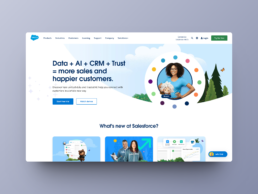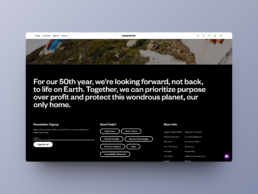Earlier this year, I wrote a blog on designing the perfect homepage. It covered six design elements every homepage needs. It was a fun post, but unfortunately, I didn’t have space to cover the second critical element of a winning homepage – the questions your homepage must answer. There are five of them, and they stand between a good design and a homepage that converts.
But first, why is there so much emphasis on the homepage?
It’s true, there are a lot of articles online that focus on your company homepage. Beyond being the primary page of your website, your homepage is like your front porch. For most businesses it’s the highest traffic page on the entire website. It’s also a form of navigation. Even those who land on your site via a product page or a service page will inevitably click to your homepage to learn more about you. It’s an open door to many paths. Your homepage needs to be able to be a catch-all of information about your business and quickly lead people to exactly what they’re looking for.
That’s a lot to fit into one page. So, designers give a lot of emphasis on the homepage. We use it to set the stage of all other pages visually, but also as a beacon of navigation. And what is navigation if not the answer to the question “where are we going”? This unlisted question is why every homepage must answer five critical questions.

Note that Salesforce doesn’t sell a CRM… it sells “more sales and happier customers”.
5 Questions Every Homepage Should Answer
1. What solution are you selling?
The moment a visitor lands on your homepage, they should be able to identify what solution you’re selling. This is true for both B2B and B2C sites, because no matter the nature of the business, your ideal customer is primarily concerned with whether you have what they want. Whether that’s your top product, top service or a special offer – it’s your job to show them quickly. Position the answer in the first section on your page, called the hero section.
As a B2B, your solution is often synonymous with your value proposition.
2. What’s your value proposition?
Once your solution is on the table, it’s time to bring in the value. A great value proposition is concise and goes a long way to improve homepage conversions. It needs to immediately tell visitors why your solution is ideal for them. If you can’t create that connection, the rest of the homepage doesn’t matter. They’ll find the solution elsewhere.
For B2B companies, having your value proposition second to ‘what you sell’ is critical. You have to connect to the person behind the screen and a company’s bottom line. Not all B2C businesses need a value proposition as one of the first things you see on a page. A visually captivating T-shirt, for example, is enough to get a website visitor to click. However, most B2C’s can still benefit from an above-the-fold value proposition of some kind if they’re in highly competitive markets.
3. Who are you?
Does it surprise you that we’re on the third question and only now getting to who you are? It shouldn’t. Remember, customers what to know if you have something that benefits them over anything else. Once you show that you have the solution they’re looking for and why it’s better suited to them, then you go in with the hand shake. The “who we are”.
A few tips on introducing your business here. Your homepage is not the place for a lengthy bio. The point is to make a connection with your website visitor. Stick to a brief one to two sentence “about you” then bring it back around to the customer. How do you fit into their world? How does your solution benefit them? If they’re interested in learning more about you, they can always click over to your about page.
Patagonia clearly addresses the “Who are we?” question towards the bottom of the page, building a connection with their ideal customer.

4. Who is your ideal customer?
One of the major red flags I see on homepages is the lack of outright saying who you’re trying to target. Website visitors are not mind readers. Web MD taught us long ago not to trust everything we read online, even if the symptoms and solutions sound like our exact situation. Consumers for both B2C and B2B need to see and read that they are your ideal customer. Tell them. Don’t make them guess.
You can do this in many ways, from the visuals you select to incorporating it into your copywriting. I recommend doing both. That way you’re creating direct and subtle connections in the visitor’s mind.
5. Are there real results?
Finally, let’s get into the results. Every B2B and B2C company needs to show some form of social proof on their homepage. Testimonials and user-generated content can boost trust and credibility in your brand. You should aim to have your first form of social proof no more than halfway down your homepage. The higher, the better.
For B2B specifically, you have several options of social proof beyond a simple testimonial. Select snippets of longer case studies can also be beneficial on the homepage. These give more data to the visitors, but should still be concise. Pull only the most critical metrics to place on the homepage. Burry the rest behind a click to ensure you keep the user engaged. For B2C businesses, you may have an even more powerful (certainly less time consuming) method of social proof that improves homepage conversion rates – user generated content. Think of consumers wearing your product and tagging you on Instagram or Tiktok. Those posts can be transposed onto your website to show potential customers what your product looks like in the real world and show how much others like it. Many websites burry these on product pages, but having them on your homepage creates an engaging hook to get customers to click on other pages.
Time to ask yourself a question
Does your homepage clearly answer all five of these critical questions? It’s easy to get caught up in the visual design, making sure your products or services are represented, yet forget to go further into answering the questions your visitors have. A great homepage balances the two so the customer feels more pulled to take action.
Use this blog as a top-down checklist and review your site. If your homepage doesn’t quite answer these questions then let’s remedy it. I’ve worked with B2B and B2C companies to create homepage refreshes that improve conversion and click-through. Together, we can turn your homepage from a catch-all to a catch-the-right-one. Contact me to schedule a call where we can look at your homepage and discuss a way to incorporate these questions into your design.
Borja Zamora
A Barcelona native but San Francisco based, Borja explores digital marketing and design through articles, images, and quotes.
Related Posts
December 9, 2024
10 Innovative Web Design Trends To Watch In 2025
Explore the top 10 web design trends for 2025, including AI personalization,…
November 18, 2024
Crafting the Future: OpenAI’s Strategic Narrative
Explore OpenAI's strategic narrative and discover how storytelling shapes its…
November 18, 2024
Unpacking Shopify’s Strategic Narrative: Rewriting the Rules of eCommerce
Explore how Shopify transformed from a snowboard shop to a global commerce…
November 12, 2024
Canva’s Strategic Narrative: How Design Democratization Created a $40 Billion Empire
Discover how Canva's strategic narrative empowers creativity through…
Related Posts
December 9, 2024
10 Innovative Web Design Trends To Watch In 2025
Explore the top 10 web design trends for 2025, including AI personalization,…
November 18, 2024
Crafting the Future: OpenAI’s Strategic Narrative
Explore OpenAI's strategic narrative and discover how storytelling shapes its…
November 18, 2024
Unpacking Shopify’s Strategic Narrative: Rewriting the Rules of eCommerce
Explore how Shopify transformed from a snowboard shop to a global commerce…
November 12, 2024
Canva’s Strategic Narrative: How Design Democratization Created a $40 Billion Empire
Discover how Canva's strategic narrative empowers creativity through…







